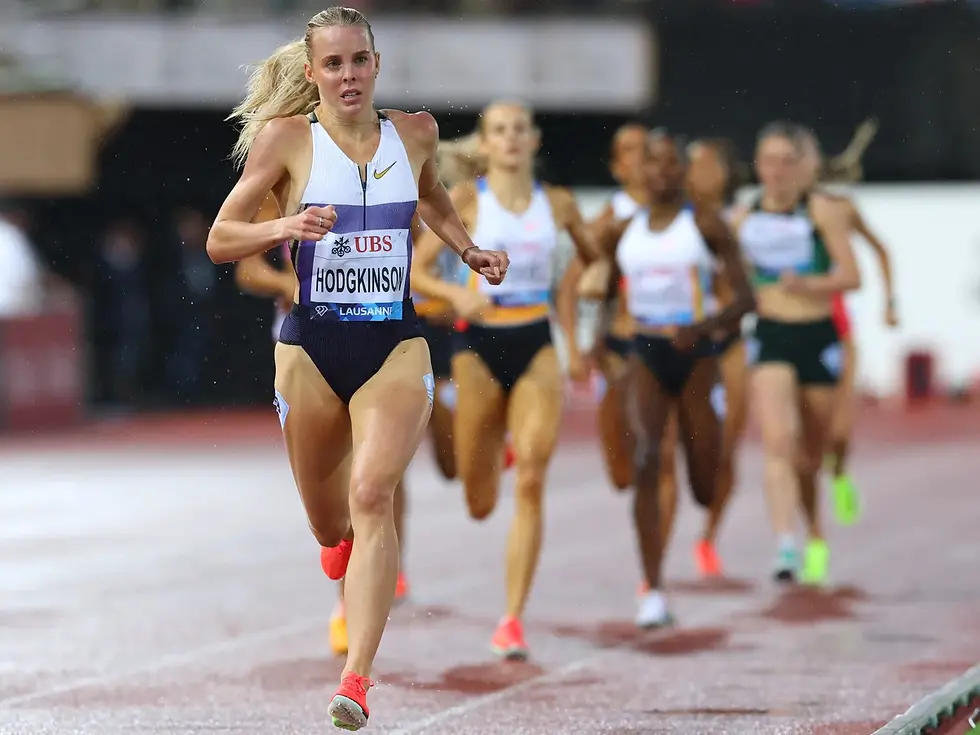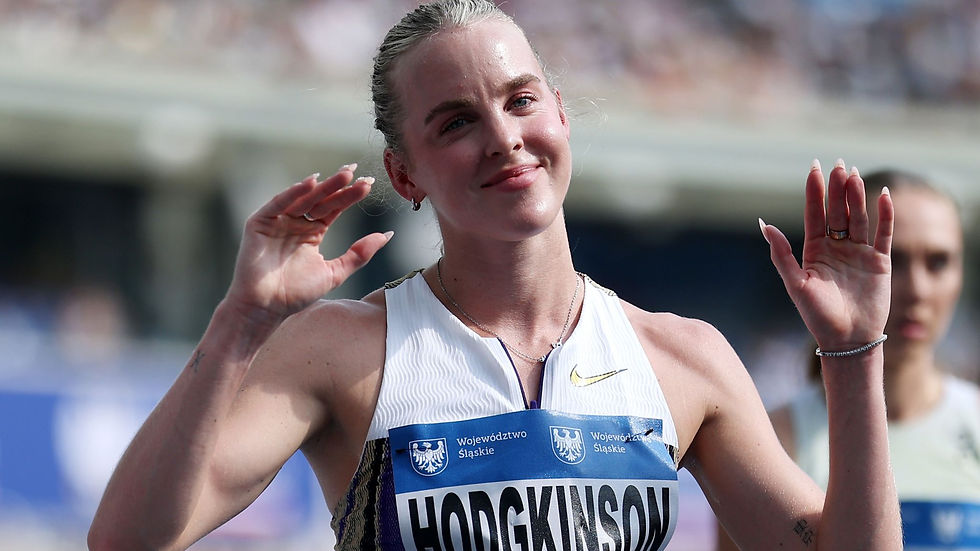The Mental Side of Injury Recovery: A Blueprint for Athletes Returning to Sport
- Robin Hughes

- 8 minutes ago
- 7 min read

Over the past week we’ve had front row seats, as we’ve watched Keely Hodgkinson return from injury after over a year out. And what she achieved was nothing short of remarkable!
5 days. 2 races. 2 wins. 1 world leading time. 1 meet record.
The question on everyone’s minds, how did she do it?!
Sit tight, because in this blog we are going to explore the psychology behind Keely’s return to running.
Injury isn’t just a physical setback, it’s a psychological battle. For athletes, the process of recovery is often more frustrating, and more mentally exhausting than the injury itself.
It’s not just about regaining strength. It’s about rebuilding confidence, navigating doubt, and re-learning how to trust your body again.
I had the pleasure of speaking with two athletes recently, Alex and Mia, who opened up about their journeys from injury to recovery. They faced identity shifts, emotional lows, and moments of fear, but ultimately came out stronger.
Here’s what they learned about the mental side of injury recovery and how you can apply it to your own comeback.
1. Injury Threatening Your Identity
For many of us, training isn’t just about fitness, it’s a core part of our identity. It shapes our daily routine, our social circles, and our sense of purpose. So when an injury takes that away, it leaves a void.
Mia felt this firsthand when she was forced to withdraw from the London Marathon:
“Suddenly, I had all this extra time. I wasn’t training, I wasn’t running, and I didn’t know what to do with myself. It felt isolating.”
She had gone from structuring her entire life around marathon training to feeling lost and unsure as to how she should fill the hours in her day.
This is a natural result of what psychologists call athletic identity foreclosure; this is when an athlete places their entire self-worth in their sport. When training is stripped away, it can trigger feelings of emptiness, frustration, or even depression, as they don’t have other strong pillars of their identity to fall back on.
The key to overcoming this? Rebuilding your identity beyond training.
Take action: Diversify your identity, your entire self is more than being an athlete, it’s being a friend, a partner, a daughter, an employee, a business owner, etc. And, as for your athletic identity, it doesn’t have to be fully informed by accomplishments and PBs. Find new ways to stay connected to your sport.
Mia started attending run clubs, even when she couldn’t run. She cycled alongside friends, carried their gels, and stayed involved in the community. This helped her maintain her identity while still respecting her body’s need for recovery.

2. The Emotional Rollercoaster of Recovery
Every athlete experiences an adapted version of Kübler-Ross’ cycle of grief, when they’re faced with injury. This is the process of initial denial/shock, anger, bargaining, depression, and eventual acceptance.
For Alex, this hit hard when he realised just how long recovery was going to take:
“You want to be back as soon as possible, so you try to test it. And then you realise that pushing too soon just sets you back further.”
Mia faced a similar struggle in the weeks leading up to the London Marathon. She had convinced herself she could push through the pain, only to wake up one morning in considerable pain. It was then that the reality set in for her:
“I had this shooting pain down my leg, and I knew, I can’t do this to myself. I can’t run this marathon just to prove a point and then be injured for another six months.”
The hardest part of injury recovery isn’t the physical pain, it’s the mental conflict of accepting what’s best for your long-term health. Many athletes fear that pulling out of a race or stepping back from training is a sign of weakness. In reality, it takes strength to show the self-discipline and forward thinking.
Take action: Work with your emotions, not against them, to move towards acceptance and a stronger comeback.
We need to remove emotion and distance ourselves from the voice trying to debate with us. This is where distanced self-talk can prove useful. You can do this is in a few ways:
Label the thought - “I am having the thought that…”
Characterise your internal voice e.g. Caveman Alex.
3rd person perspective - “What advice would you give a friend?”
If the uncomfortable emotions and thoughts persist, then utilise a line of questioning used by psychologists called Socratic questioning. This is where we unpack thoughts and beliefs to understand them and the situation better. Start with these three questions:
What facts do I have about my recovery vs. what assumptions am I making?
How can I make the most of this phase of recovery?
Am I seeing this setback as permanent, or is this just a temporary challenge?

3. Overcoming the Fear of Re-Injury
Even after an athlete is cleared to train, one of the biggest barriers to performance isn’t physical, it’s psychological hesitation. The body is ready, but the mind keeps whispering: “What if it happens again?”
Mia found herself battling these thoughts every time she ran:
“I’d be mid-run thinking, ‘Can I even do this? Is my leg going to hold up?’ And that doubt would creep in.”
Alex experienced the same thing, realizing that the fear of re-injury was holding him back more than the injury itself.
“Physically, I was fine. But mentally, I was still cautious, almost waiting for something to go wrong.”
This hesitation is a natural protective mechanism to be expected coming back from injury. The brain is trying to shield us from the physical and mental pain of going through an injury again. However, in reality, this can lead to a self-fulfilling prophecy where overthinking leads to a drop in focus, unnatural movement patterns, and an increase in risk of causing another injury.
The best way to counter this? Expose yourself to controlled discomfort, log your progress, and visualise moving with confidence.
Take action: Gradually rebuild your confidence in the injured area to perform, with small, safe challenges, just like Alex did:
“I focused on small wins, short, controlled runs where I knew I wouldn’t overdo it. Each one built my confidence back up.”
Track these wins in your ‘Injury Confidence Cookie Jar’. This will build evidence to refute your brain's concerns & worries.
And finally, spend time visualising yourself moving comfortably, assured, and with poise. Imaging a smooth movement and utilisation of your injured body part, activates the same neural pathways as physically doing the movement. This will break down the mental blocker stopping you moving with confidence, and help you get back to normal movement quicker.

4. The Two Types of Support Every Athlete Needs
Recovering from injury isn’t just about confidence in yourself, it’s about having confidence in the right people.
Mia realised this when she sought out informational support by looking for a coach:
“Physios tell you what you can’t do. My coach told me what I could do. That made all the difference.”
For her, trusting a professional to guide her recovery meant she didn’t have to second-guess every decision. Identifying your knowledge gaps and identifying someone who is knowledgeable in those areas, to map out the process, relieved the mental burden of figuring it out alone, whilst giving her confidence that she was doing the right things to improve.
Alex, on the other hand, prioritised emotional support using his peers as his biggest source of support:
“Having people check in, even just asking how things were going, helped me stay connected and reminded me I wasn’t in this alone.”
Emotional support from friends, family, and training partners can make all the difference. Injury can feel isolating, but staying engaged with your training community, even if you can’t fully participate, keeps you in the game mentally.
Take action: Identify who in your support network you need to lean on, and what type of support you need.
Do you have a knowledge gap and need informational support?
Do you need to share the load with some emotional support?
Do you have a coach or medical expert you trust?
Do you have friends or teammates to lean on?
If not, seek support, whether professional or social, you don’t have to do this alone.

5. Stop Comparing Yourself to Your Pre-Injury Self
Most athletes assume their biggest mental challenge during recovery will be comparing themselves to others. But in reality, the hardest part is comparing yourself to your past, injury-free self.
Alex noticed this as he returned to training:
“I kept thinking, ‘I used to be able to do this easily, why can’t I now?’ It was frustrating because I wasn’t competing against anyone else. I was just chasing who I used to be.”
This mindset can be damaging, leading athletes to feel like they’re always behind and chasing something. Rather than moving forward with the hand they’ve been dealt and celebrating their progress, they will constantly compare through rose tinted glasses.
Mia flipped this perspective, seeing her comeback as an opportunity to experience rapid progress again, just like when she first started running:
“When you first start a sport, you improve so fast. Injury recovery is like that, you get to have that feeling of progress again, setting new ‘post-injury PBs’ instead of chasing what you used to be.”
Take action: Instead of thinking “I used to be able to do this”, shift your mindset to “What can I achieve now?”
Track your post-injury milestones (first pain-free run, longest distance since injury, new training habits).
Set new PBs based on current progress, not past performance.
Focus on growth, not comparison, because the best athletes don’t just recover, they evolve.
Final Thoughts: The Mindset of a Comeback
Injury isn’t just a physical battle, it’s a mental one.
To return stronger, you must:
✅ Diversify your athletic identity – You are more than your sport.
✅ Accept the emotional cycle – This isn’t your life forever, zoom out.
✅ Overcome the fear of re-injury – Trust your training and body again.
✅ Lean on your support system – Recovery isn’t meant to be done alone.
✅ Redefine success – Stop chasing your pre-injury self.
Thank you to Alex and Mia for sharing their inspiring experiences, and proving that setbacks don’t define you, how you come back does. Which strategy are you taking into your recovery today?
Want to train your mind like an elite athlete? Download the Getahead app and start your mental fitness journey today.
Robin Hughes
Head of Mental Fitness, Getahead



Comments